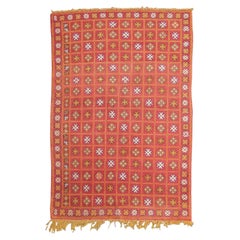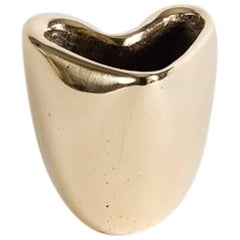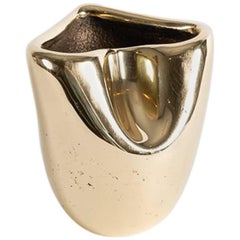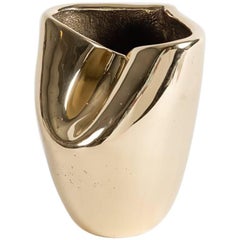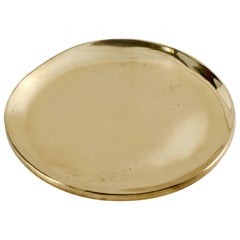North African Furniture
161
33
21
to
2
130
84
215
185
185
17
6
3
1
1
16
7
138
54
16
66
52
1
5
12
7
11
10
15
6
1
132
107
49
39
33
249
48,504
15,507
10,512
8,972
31
10
3
1
1
Place of Origin: North African
Recognized Seller Listings
Moroccan Rug, Mid-20th Century
Located in San Francisco, CA
Moroccan Rug, Mid-20th Century
Additional Information:
Dimensions: 3'5" W x 5'2" L
Condition: Excellent
Category
Mid-20th Century North African Furniture
Materials
Wool
Jaimal Odedra, "Rana", sand cast bronze platter, Morocco, 2015
By Jaimal Odedra
Located in New York, NY
"Rana"
Bronze platter by Jaimal Odedra, with handmade wood box. Each piece is sand cast by artisans in Morocco.
Stamped: Jaimal Odedra. Weight: 2.3 kg
Category
2010s North African Furniture
Materials
Bronze
Jaimal Odedra "Heart, " Extra Small Contemporary Urn, Bronze, Morocco, 2018
By Jaimal Odedra
Located in New York, NY
Signed: Jaimal Odedra
Each piece is modeled and cast by hand using a traditional Moroccan sand casting method.
"In creating these works, I was interested in exploring and enhan...
Category
2010s North African Furniture
Materials
Bronze
Jaimal Odedra, "Heart, " Small Contemporary Urn, Bronze, Morocco, 2018
By Jaimal Odedra
Located in New York, NY
Signed: Jaimal Odedra
Each piece is modeled and cast by hand using a traditional Moroccan sand casting method.
"In creating these works, I was interested in exploring and enhan...
Category
2010s North African Furniture
Materials
Bronze
Jaimal Odedra, "Heart, " Large Contemporary Urn, Bronze, Morocco, 2018
By Jaimal Odedra
Located in New York, NY
Signed: Jaimal Odedra
Each piece is modeled and cast by hand using a traditional Moroccan sand casting method.
"In creating these works, I was interested in exploring and enhan...
Category
2010s North African Furniture
Materials
Bronze
Jaimal Odedra, "Rana", sand cast bronze platter, Morocco, 2015
By Jaimal Odedra
Located in New York, NY
"Rana"
bronze platter by Jaimal Odedra, with handmade wood box. Each piece is sand cast by artisans in Morocco.
Stamped: Jaimal Odedra. Weight: 4.8 kg.
Category
2010s North African Furniture
Materials
Bronze
Exceptional Egyptian Sarcophagus Mask
Located in London, GB
Exceptionally Fine Wooden Sarcophagus Mask
Third Intermediate Period, 21st Dynasty, circa 1069-945 BC.
Acacia wood, rosewood, hippopotamus ivory
Masterfully carved from a single piece of fine-grained hardwood, the present mask is characteristic of the most exquisite funerary art made during the 21st Dynasty, and was probably commissioned for a particularly high-ranking individual.
The oval face displays a gently smiling mouth with full, outlined lips, furrows at the corners and a bow-shaped philtrum. The straight nose with rounded nostrils, the cheeks full and fleshy and the large, almond shaped eyes with heavy lids and tapering cosmetic lines, set below long, sweeping eyebrows.
Social collapse across the Mediterranean in the Late Bronze Age meant that the 21st Dynasty in Egypt was a period of great turmoil. Trade routes were disrupted, governments collapsed, and mass migration occurred. Economic scarcity meant that traditional funerary practices in Egypt were also affected, with a lack of material and financial resources leading to the reuse of preexisting material. As a result, during the 21st Dynasty, 19th and 20th Dynasty coffins changed ownership rapidly and were heavily recycled for new purposes. Tombs were also unmarked allowing them to be shared
by many people. These new practices brought forth a shift in the understanding of funerary paraphernalia. No longer important objects owned forever by the deceased, they were now simply seen as short-term transformative devices, whose symbolic and ritualistic meaning could be appropriated for others. However, paradoxically, the art of coffin-making also reached new heights during this period, and many of the richly dec- orated “yellow” coffins, characteristic of the 21st Dynasty, are remarkable works of art in their own right. Indeed, knowing that coffins were being reused throughout Egypt, the Egyptian élite set themself apart by commissioning lavish sarcophagi decorated with the images and texts meant to help guide them to the afterlife, and which would otherwise have adorned the tomb walls. As coffins were the chief funerary element which now identified the dead and allowed them a physical presence in the world of the living, their quality and appearance were of the utmost importance.
The traditional coffin ensemble was made of three parts: a wooden mummy cover, which laid directly atop the mummy, an inner coffin, and an outer coffin, both made of a lid and case. Additional decorative elements, such as masks, were carved out separately and later glued or pegged to the lids. After the completion of the painted decoration, the sarcophagus was covered in a varnish to give it its yellow colour. Gilding was sometimes used for the coffins of the high priests’ families, notably on parts representing naked skin, such as the face mask. However, some of the élite tactically avoided gilding altogether as to ensure that their coffin would not be looted.
When manufacturing the inner and outer coffins, particular attention was paid to the woodwork. Displaying the skill of the carpenter, this type of funerary art has largely remained unparalleled throughout Egyptian history. The principal wood used to craft the present mask is Acacia nilotica. The evergreen Egyptian acacia was considered sacred and said to be the tree of life, the birthplace of the god Horus, as well as symbolic of Osiris, the god of the dead and resurrection. The modelling of the face in the wood is superb, but the inlays also help mark this mask out as exceptional. Inlaid eyes and eyebrows were extremely rare and reserved to the finest and most expensive coffins. Traditionally, eyes were made of calcite, obsidian, or quartz, and eyebrows of coloured glass paste or bronze. Here, the pupils, eyebrows, and cosmetic lines are inlaid with Dalbergia melanoxylon, a rare type of wood which belongs to the rosewood genus.
In antiquity, however, it was known as Ebony of the Pharaohs, from the Egyptian word “hbny”, meaning dark timber, because of its black, lustrous appearance. An extremely dense and hard wood requiring significant skill to work with, ebony was a luxury material highly coveted by the pharaohs themselves, to make furniture, decorative and funerary objects. The wood was imported with great effort from the southern Land of Punt, most likely modern Sudan, Ethiopia, Djibouti, and Eritrea, alongside other luxury goods such as gold and ivory.
A magnificent ebony throne, recovered in the tomb of King Tutankhamun, illustrates the incredible aesthetic potential of this material and why it was so highly valued by Egyptian royalty. Only élite members of Egyptian society could have afford- ed Ebony of the Pharaoh inlays for their funerary mask.
The sclerae on the present piece were once both inlaid with hippopotamus ivory. Whiter than elephant ivory, this type of ivory is also denser, and more difficult to carve. The use of this luxury material, reputed for its gleaming appearance, enhances the lifelikeness of the eyes. For the Egyptians, hippopotamus ivory was imbued with magic powers. The hippopotamus was indeed both feared and venerated due to its aggressive behaviour. Whilst the male hippopotamus was associated with danger and chaos, the female was benevolent and invoked for protection, especially of the house and
of mothers and their children, through the hippopotamus goddess Tawaret. Thus, not only was hippopotamus ivory used as an inlay and to make practical objects, such as combs and clappers, but it was also used to make talismans like apotropaic wands or knives.
Made during a time of scarcity where few could afford made-to-order coffins, the present mask could have only belonged to one of the highest-ranking individuals in society. Undoubtedly one of the finest Egyptian coffin...
Category
15th Century and Earlier Egyptian Antique North African Furniture
Materials
Fruitwood, Hardwood
Outstanding Vintage Moroccan Berber Beni Ouarain Rug in White and Black
Located in Milan, IT
The Beni Ouarain confederation is composed of seventeen tribes inhabiting the northeastern portion of the Middle Atlas mountains in Morocco. Their rugs differ from other Berber weav...
Category
Mid-20th Century Mid-Century Modern North African Furniture
Materials
Wool
Vintage Moroccan Berber Beni Ouarain Rug in White/Mocha and Rare Size
Located in Milan, IT
The rugs of the Beni Ouarain tribal confederacy differ from other Berber weavings in that they are woven almost exclusively on an ivory background and decorated with abstract geometr...
Category
1960s Mid-Century Modern Vintage North African Furniture
Materials
Wool
Ancient Egyptian Monumental Temple Sphinxes
Located in London, GB
A pair of monumental limestone sphinxes of Pharaoh Nectanebo I, from the processional avenue of the Serapeum of Memphis, 30th Dynasty, circa 379 - 360 BC.
The sphinxes of the Serapeum have captivated travellers since Roman times. However, despite their significance, they are conspicuously absent from the collections of most major museums. Indeed, their existence in private hands is so improbable, and their imitations so numerous, that the present sphinxes were assumed to be modern copies throughout their recent ownership history. Finally recognised and conserved after an extraordinary chance discovery at a garden furniture sale...
Category
15th Century and Earlier Egyptian Antique North African Furniture
Materials
Limestone
Rare and Unusual Vintage Geometric Beni Ouarain Moroccan Berber White/Mocha Rug
Located in Milan, IT
The Beni Ouarain confederation is composed of seventeen tribes inhabiting the northeastern Middle Atlas mountains in Morocco. Their rugs differ from other Berber weavings in that the...
Category
Mid-20th Century Mid-Century Modern North African Furniture
Materials
Wool
Vanadinite on Barite, Mibladen, Midelt Cercle, Midelt Prov., Morocco
Located in New York, NY
VANADINITE ON BARITE
Mibladen, Aït Oufella Caïdat, Midelt Cercle, Midelt Province, Drâa-Tafilalet Region, Morocco
12.7 cm tall x 14 cm wide
The Drâa-Tafilalet Region of Morocco, best...
Category
15th Century and Earlier Antique North African Furniture
Materials
Other
Old and Unusual Beni Ouarain Berber Rug
Located in Milan, IT
The Beni Ouarain confederation is composed of seventeen tribes inhabiting the high mountain region of the northeastern Middle Atlas. Their rugs differ from other Berber weavings in t...
Category
1950s Mid-Century Modern Vintage North African Furniture
Materials
Wool
Fine Vintage Henna-Dyed Beni Ouarain Minimalist Moroccan Berber Rug
Located in Milan, IT
The Beni Ouarain confederation is composed of seventeen tribes inhabiting the high mountain region of the northeastern Middle Atlas, in northern Morocco. Their rugs differ from othe...
Category
Late 20th Century Minimalist North African Furniture
Materials
Wool
Vintage Square Beni Ouarain White Moroccan Berber Rug
Located in Milan, IT
The Beni Ouarain is a confederation of seventeen tribes inhabiting the high mountain region of the northeastern Middle Atlas, in northern Morocco. Their rugs differ from other Berber...
Category
Late 20th Century Tulu North African Furniture
Materials
Wool
Stunning Vintage Beni Mguild Moroccan Berber Rug in Blue and White
Located in Milan, IT
The rugs of the Beni Mguild tribe, located in the Moroccan Middle Atlas mountains, are often distinguished by rich monochromatic tonalities, typically in shades of red or blue. These...
Category
1970s Tribal Vintage North African Furniture
Materials
Wool
Vintage White Beni Ouarain Moroccan Berber Rug
Located in Milan, IT
The Beni Ouarain confederation is composed of seventeen tribes inhabiting the high mountain region of the northeastern Middle Atlas in Morocco. Their rugs differ from other Berber we...
Category
Mid-20th Century Tulu North African Furniture
Materials
Wool
Rare Double Face Vintage Moroccan Berber Open Field Rug
Located in Milan, IT
A rare Middle Atlas Berber rug from the Zemmour region, distinguished by the fact that it has pile on both sides- red in different gradations on the displayed side and orange in many...
Category
1970s Tribal Vintage North African Furniture
Materials
Wool
Vintage Moroccan Boucherouite Berber Prayer Rug
Located in Milan, IT
Woven by using exclusively recycled yarns of various type, ranging from cotton to lurex, Boucherouite Berber rugs represent a unique facet of Moroccan textile art...
Category
Late 20th Century Folk Art North African Furniture
Materials
Cotton
Egyptian Head of a Man
Located in London, GB
Egyptian head of a man, carved granite. 18th Dynasty, circa 1550-1292 B.C.
Carved in beautiful dark granite, this head depicts an elite individual, perha...
Category
15th Century and Earlier Egyptian Antique North African Furniture
Materials
Granite
Vintage Boujad Moroccan Berber Rug with Dripping Colour
Located in Milan, IT
Here, the surface is entirely covered by vertical and vaguely parallel black lines, which move organically across an orange-yellow background, just like drip painting on a canvas. Th...
Category
1980s Tribal Vintage North African Furniture
Materials
Wool, Cotton
Vintage Ourika Miniature Berber Moroccan Rug with Abstract Squares
Located in Milan, IT
Located south of Marrakesh, along the northern slopes of the High Atlas Mountains, the Ourika valley is known primarily for its covers in undyed ivory and brown wool depicting a moon...
Category
1970s Tribal Vintage North African Furniture
Materials
Wool
Vintage Zindhek Moroccan Berber Double Sided Rug with Abstract Pattern
Located in Milan, IT
Zindheks represent the most basic utilitarian weaving of Morocco's material culture. Woven with recycled and/or industrial fibers (more rarely with wool) by hooking the yarn through ...
Category
Early 2000s Tribal North African Furniture
Materials
Cotton
Vintage Azilal Berber Moroccan White Miniature Rug with Black Directional Motifs
Located in Milan, IT
Azilal rugs woven with natural, undyed ivory and brown/black wool constitute the most renowned body of weavings for this area. Their popularity is due perhaps to their aesthetic affi...
Category
1980s Tribal Vintage North African Furniture
Materials
Wool, Cotton
Vintage Zindhek Berber Moroccan Rug Depicting a Village Scene
Located in Milan, IT
Zindheks represent the most basic utilitarian weaving of Morocco’s material culture. Woven with recycled and/or industrial fibres (more rarely with wool) by hooking the yarn through ...
Category
Early 2000s Tribal North African Furniture
Materials
Cotton
Vintage Azilal Moroccan Berber Rug with Tagine Pot Design
Located in Milan, IT
This cute little Azilal rug shows a directional pattern culminating into what appears to be the pot used to cook tagine, which is a traditional Moroccan dish...
Category
1980s Tribal Vintage North African Furniture
Materials
Wool
Small Moroccan "Boucherouite" or Azilal Rug
Located in New York, NY
Small Moroccan "Boucherouite" or Azilal rug. A Moroccan rag rug, woven with cut-up pieces of fabric from old clothes, etc. - boucherouite means rag or t...
Category
Late 20th Century Tribal North African Furniture
Materials
Cotton
Vintage Azilal Berber Moroccan Rug with Animal Pelt Pattern and Woven Charms
Located in Milan, IT
A very finely woven rug with an elegant, even surface depicting an arrangement of mixed ivory/brown undyed wool, with an effect similar to that of a zebra pelt. The background is emb...
Category
Late 20th Century Tribal North African Furniture
Materials
Wool, Cotton
Vintage Abstract Boujad Moroccan Berber Rug with Anthropomorphic Figure
Located in Milan, IT
Since the 13th century the Boujad region has been the epicentre of Moroccan Islamic mysticism, influencing greatly the Berber population of the area, who in turn embraced disciplines...
Category
Late 20th Century Tribal North African Furniture
Materials
Cotton, Wool
Vintage Abstract Boujad Moroccan Berber Rug with Vertical Brushstrokes
Located in Milan, IT
A group of narrow runners with bold patterns and frequent use of recycled and synthetic fabrics appears to originate from the western foothills. Another example of long rug, originat...
Category
Late 20th Century Tribal North African Furniture
Materials
Cotton, Wool
Vintage Azilal Moroccan Berber Rug with a Green Monolith on an Orange Background
Located in Milan, IT
At the 9th International Conference on Oriental Rugs, which gloriously took place in Milan in 1999, Mustapha Hansali presented his research based on field trips to the Azilal region....
Category
1980s Tribal Vintage North African Furniture
Materials
Cotton, Wool
Vintage Azilal Berber Moroccan Miniature Rug with Parallel Interlocking Devices
Located in Milan, IT
Also belonging to the 'colored Azilal' subgroup is this sweet miniature rug, with its pattern of crenellated totemic devices, in which the weaver fully displays her ability to work o...
Category
Late 20th Century Tribal North African Furniture
Materials
Cotton, Wool
Extremely Fine Antique Silk and Wool Kilim with Anthropomorphic Figures
Located in Milan, IT
An extremely fine pillow case from the Gafsa region in central Tunisia, exquisitely woven in wool with silk details, decorated by geometric motifs arranged along horizontal compartme...
Category
Early 20th Century Tribal North African Furniture
Materials
Silk, Wool
Fine Antique Moroccan Berber Checkerboard Design Flat-Woven Rug in Earth Tones
Located in Milan, IT
A very elegant and refined Berber weaving, composed of an honeycomb arrangement of ivory, chocolate brown and black squares contained within horizontal compartments. The extreme fine...
Category
1930s Art Deco Vintage North African Furniture
Materials
Wool
Lunar Meteorite
Located in London, GB
A Piece of the Moon - Superb Lunar Meteorite
NWA 11303
4.5 Billion y/o
This beautiful lunar meteorite fragment belongs to NWA 11303, a fel...
Category
15th Century and Earlier Antique North African Furniture
Materials
Stone
Vintage Black Ground Boujad Moroccan Berber Rug with Polychrome Stepped Diamonds
Located in Milan, IT
Rugs named after the town of Boujad were woven by Arab or Arabised Berber tribes, who are principally located on the southwestern foothills of the Middle Atlas mountains, in a region...
Category
1970s Tribal Vintage North African Furniture
Materials
Wool
Vintage White/Dark Brown Moroccan Berber Beni Ouarain Rug
Located in Milan, IT
The Beni Ouarain confederation is composed of seventeen tribes inhabiting the high mountain region of the northeastern Middle Atlas in Morocco. Their rugs differ from other Berber we...
Category
Mid-20th Century Mid-Century Modern North African Furniture
Materials
Wool
"Rupi" Sand Cast Bronze Bowl by Jaimal Odedra
By Jaimal Odedra
Located in New York, NY
"Rupi"
Bronze bowl by Jaimal Odedra. The "Rupi" bowls are made in five sizes, which may be used individually or as a set of nesting bowls. This is the third largest size out of fi...
Category
2010s North African Furniture
Materials
Bronze
Azilal Moroccan Berber Rug (DK-125-90)
Located in New York, NY
A lovely Moroccan Berber rug from the Azilal province in the Central High Atlas Mountains with a delicately and whimsically drawn grid design on a white background. Generous proporti...
Category
Late 20th Century Minimalist North African Furniture
Materials
Wool, Cotton
Antique Moroccan Rabat Long Rug, 19th Century
Located in San Francisco, CA
Antique Moroccan Rabat Long Rug, 19th Century
Moroccan carpet weaving has a long but ambiguous history. In comparison to examples from the 20th century, few 19th-Century or earlier ...
Category
19th Century Antique North African Furniture
Materials
Wool
Red Moroccan Berber Rug (DK-125-89)
Located in New York, NY
A great example showing how the accidental color shifts, called “abrash” in rug trade, can enhance a seemingly monochromatic rug. Note the two half-finished star or flower mot...
Category
Late 20th Century Minimalist North African Furniture
Materials
Wool
Beni Mguild Berber Rug (DK-125-85)
Located in New York, NY
Beni Mguild Moroccan Berber Rug. A lovely old Moroccan Berber rug from the Middle Atlas Mountains, attributed to the Beni Mguild, featuring one of the well-known designs and the char...
Category
Mid-20th Century Tribal North African Furniture
Materials
Wool
"Rupi" Sand Cast Bronze Bowl by Jaimal Odedra
By Jaimal Odedra
Located in New York, NY
"Rupi"
Bronze bowl by Jaimal Odedra. The "Rupi" bowls are made in five sizes, which may be used individually or as a set of nesting bowls. This is the third largest size out of five...
Category
2010s North African Furniture
Materials
Bronze
Beni Ouarain Berber Carpet (DK-125-87)
Located in New York, NY
A classic Beni Ouarain tribal carpet from the Northeastern Middle Atlas Mountains, with the typical diamond grid pattern in small scale - note the pattern change at the bottom, which...
Category
Mid-20th Century Tribal North African Furniture
Materials
Wool
Cross-Section from an Exceptional Lunar Meteorite
Located in London, GB
A piece of the moon - superb lunar meteorite gadamis 004 - Anorthosite
4.5 Billion y/o
Among the rarest substances to be found on Earth, thi...
Category
15th Century and Earlier Antique North African Furniture
Materials
Stone
Early 20th Century Moroccan Silver Jewish Amulet in the Shape of a Fish
Located in New York, NY
A rare, handmade standing sculptural amulet in the form of a fish. Unlike similar items that are mostly two-dimensional and are meant to be hanged only, this amulet is a standing sculpture in the round. The fish's eyes are made of coral, a gem stone typical of North-Africa. The body of the fish is hand-engraved with symbols from the Jewish Moroccan...
Category
Early 20th Century Folk Art North African Furniture
Materials
Coral, Silver
Oriented Stone Meteorite
Located in London, GB
Oriented Stone Meteorite
Chondrite
5.00 kg
Detached from its parent body by a mighty impact, this large, oriented Meteorite travelled over a hu...
Category
15th Century and Earlier Antique North African Furniture
Materials
Stone
Largest "Rupi, " Sand Cast Bronze Bowl by Jaimal Odedra
By Jaimal Odedra
Located in New York, NY
"Rupi"
Bronze bowl by Jaimal Odedra. The "Rupi" bowls are made in five sizes, which may be used individually or as a set of nesting bowls. This is the largest size out of five.
...
Category
2010s North African Furniture
Materials
Bronze
Vintage Moroccan Berber Kilim Rug with Natural Undyed Wool
Located in Milan, IT
A rare and unique Berber flat-weave called haik originating from the Mejjat tribe, located in the most southern part of the Moroccan Anti Atlas region. Woven in alternating shades of...
Category
Mid-20th Century Kilim North African Furniture
Materials
Wool
Lunar Meteorite
Located in London, GB
A beautiful fragment from a lunar meteorite, among the rarest of all geological finds. This specimen belongs to NWA 11303, a feldspathic regolith breccia which formed when the shock ...
Category
15th Century and Earlier Antique North African Furniture
Materials
Stone
Vintage Mejjat Berber 'Desert Sand' Flat-Weave Haik Rug
Located in Milan, IT
A finely woven haik from the Mejjat tribe, located in the most southern part of the Moroccan Anti Atlas region. Distinguished for their blanket-like handle and for their unique icono...
Category
Mid-20th Century Tribal North African Furniture
Materials
Wool
A Piece of Mars - Martian Meteorite
Located in London, GB
MARTIAN STONE - NWA 14713
Lherzolitic shergottite
127 g
“This 127-gram fragment of the NWA 14713 meteorite displays a green-black mottled exterior. The rock is a martian shergottite (a basalt) composed mainly of coarse grains of pyroxene as well as calcium-plagioclase glass. This glass, called maskelynite, formed from crystalline plagioclase when the specimen was blasted off the surface of Mars by an energetic collision. There are currently less than 350 known martian meteorites...
Category
15th Century and Earlier Antique North African Furniture
Materials
Stone
Cross Section of Exceptional Lunar Meteorite
Located in London, GB
“This 149-gram slice of the Gadamis 004 lunar meteorite contains a wide variety of sizes of light-colored angular anorthositic clasts. These silicate c...
Category
15th Century and Earlier Antique North African Furniture
Materials
Stone
Monolithic Stone Meteorite
Located in London, GB
Unclassified Meteorite
Stone
Height: 36.83 cm
42.5 kg
A dramatic extraterrestrial sculpture, of monolithic form, covered in a thick grey-brown fusion crust and with areas of sandy deposits from untold years spent on the desert floor. Formed in the asteroid belt between Mars and Jupiter during the formation of our solar system, some 4.55 billion years ago, this large stone would have been separated from its parent body by an enormous impact before journeying through interplanetary space and eventually reaching Earth.
Upon atmospheric entry it would have reached cosmic velocity, heating the surrounding air to 1700°C and producing a large ball of fire. The heat was sufficient to melt the outer surface of the stone, exposing a new surface which in turn also melted away, losing as much as 95% of its initial mass before reaching the ground. The last molten layer to form as it collided with the Earth covered the stone in a layer of fusion crust, evidence of the incredible impact force delivered by this extraordinary specimen.
“This unclassified stone meteorite was found in Northwest Africa. It has a relatively smooth, dark brown, slightly weathered fusion crust; some small melt veins are visible on the surface. Due to the near-absence of terrestrial rocks in this region of the Sahara, meteorite hunting in this area has yielded many notable discoveries.”
Dr Alan E. Rubin, PhD Department of Earth, Planetary, and Space Sciences...
Category
15th Century and Earlier Antique North African Furniture
Materials
Stone
Vitrified Lightning Bolt
Located in London, GB
An Extraordinarily well preserved specimen of Fulgurite
Tubular Lechatetierite
Formation date unknown, recovered from the Sahara Desert, Algeria, ...
Category
15th Century and Earlier Antique North African Furniture
Materials
Glass
Large Chondrite Meteorite with Regmaglypts
Located in London, GB
NWA 12759
Stone, Chondrite - L5
18.3 KG
“This specimen of the NWA 12759 L5 chondrite has a smooth posterior fusion crust where meteoritic melt pooled as the rock descended through the atmosphere and was heated by friction with molecules of air. The meteorite is from the L-chondrite asteroid that was destroyed by an energetic collision 470 million years ago.”
Dr Alan E. Rubin, PhD Department of Earth, Planetary, and Space Sciences, UCLA
Detached from its parent body by a mighty impact, this large, oriented meteorite travelled over a hundred million miles through space before falling to Earth in the North African desert. Beautiful regmaglypts radiate from the apex of its cone shaped nose. These elongated dimples formed when streaks of superheated molten rock streamed off the meteor’s surface as it blazed through the atmosphere. The entire piece is coated in a glossy, umber-coloured fusion crust and close examination reveals remnants of encrusted, orange dirt.
Whilst most meteors tumble as they travel through the Earth’s atmosphere, oriented meteorites...
Category
15th Century and Earlier Antique North African Furniture
Materials
Stone
Meteorite Impact Desert Glass
Located in London, GB
Libyan Desert Glass
Circa 29 Million y/o
Height: 9.5 cm
A beautiful, tactile piece of yellow glass, found between the high crested dunes of the Libyan De...
Category
15th Century and Earlier Antique North African Furniture
Materials
Glass
Three Sand Cast Bronze Bowls by Jaimal Odedra
By Jaimal Odedra
Located in New York, NY
3 Bronze bowls by Jaimal Odedra.
Each piece is sand cast by artisans in Morocco. Stamped: Jaimal Odedra.
Dimensions of three bowls as follows.
3.25" ...
Category
2010s North African Furniture
Materials
Bronze
Recently Viewed
View AllMore Ways To Browse
Vintage Compact
Antique And Vintage Oak Furniture
Vintage Money
Cabinets By Baker
Wooden Cabinet Glass Door
Baroque Italian Cabinet
Cabinet White Light
Walnut 3 Drawer
White Lighted Cabinet
White Display Cabinets
White Display Cabinet
Case Pieces And Storage With Carved Flowers
Art Nouveau Flower Stand
Blue Cabinet Glass
Black Deco Drawers
Asian Pictures
Bombe Louis
Sliding Glass Doors And Glass Shelves
